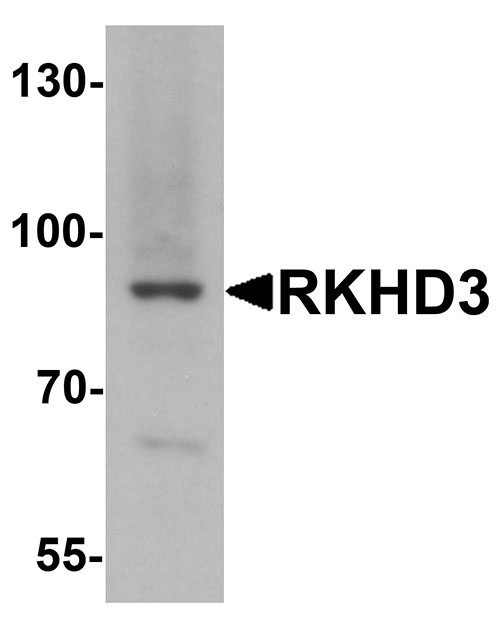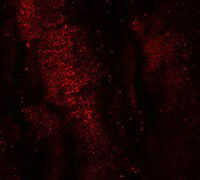RKHD3 Antibody
- 产品详情
- 实验流程
- 背景知识
Application
| WB, IF, E |
|---|---|
| Primary Accession | Q6ZN04 |
| Other Accession | NP_780575, 47716512 |
| Reactivity | Human, Mouse, Rat |
| Host | Rabbit |
| Clonality | Polyclonal |
| Isotype | IgG |
| Calculated MW | 58832 Da |
| Concentration (mg/ml) | 1 mg/mL |
| Conjugate | Unconjugated |
| Application Notes | RKHD3 antibody can be used for detection of EPAC1 by Western blot at 1 µg/mL. Antibody can also be used for immunofluorescence starting at 20 µg/mL. For immunofluorescence start at 20 µg/mL. |
| Gene ID | 84206 |
|---|---|
| Other Names | RNA-binding protein MEX3B, RING finger and KH domain-containing protein 3, RING finger protein 195, MEX3B, KIAA2009, RKHD3, RNF195 |
| Target/Specificity | MEX3B; This antibody is specific for RKHD3 and will not recognize the other RKHD3 family of proteins. |
| Reconstitution & Storage | RKHD3 antibody can be stored at 4℃ for three months and -20℃, stable for up to one year. As with all antibodies care should be taken to avoid repeated freeze thaw cycles. Antibodies should not be exposed to prolonged high temperatures. |
| Precautions | RKHD3 Antibody is for research use only and not for use in diagnostic or therapeutic procedures. |
| Name | MEX3B |
|---|---|
| Synonyms | KIAA2009, RKHD3, RNF195 |
| Function | RNA-binding protein. May be involved in post-transcriptional regulatory mechanisms. |
| Cellular Location | Nucleus. Cytoplasm. Cytoplasm, P-body. Cytoplasmic granule. Note=Predominantly expressed in the cytoplasm and shuttles between the cytoplasm and the nucleus through the CRM1 export pathway. Localization to P-bodies is dependent on 14-3- 3 |
| Tissue Location | Highest levels found in fetal brain and testis. Detected in the adult intestinal epithelium, specifically in goblet cell at protein level. |
For Research Use Only. Not For Use In Diagnostic Procedures.
Provided below are standard protocols that you may find useful for product applications.
BACKGROUND
RKHD3 Antibody: Rkhd3, also known as MEX3B is a member of a novel family of four homologous human MEX3 proteins each containing two heterogeneous nuclear ribonucleoprotein K homology (KH) domains and one carboxy-terminal RING finger module. MEX3 proteins, including Rkhd3, are phosphoproteins that bind RNA through their KH domains and shuttle between the nucleus and the cytoplasm via the CRM1 export pathway. These proteins are a novel family of evolutionarily conserved RNA-binding proteins, differentially recruited to P bodies and potentially involved in post-transcriptional regulatory mechanisms. Rkhd3 is thought to act as a mechanism to fine-tune mRNA regulation in early Xenopus development, and with Rkhd4, but not Rkhd1, will co-localize with both the hDcp1a decapping factor and Argonaute (Ago) proteins in processing bodies (P bodies), recently characterized as centers of mRNA turnover.
REFERENCES
Takada H, Kawana T, Ito Y, et al. The RNA-binding protein Mex3b has a fine-tuning system for mRNA regulation in early Xenopus development. Dev. 2009; 136:2413-22
Draper BW, Mello CC, Bowerman B, et al. MEX-3 is a KH domain protein that regulates blastomere identity in early C. elegans embryos. Cell 1996; 87:205-16.
Liu J, Valencia-Sanchez MA, Hannon GJ, et al. MicroRNA-dependent localization of targeted mRNAs to mammalian P-bodies. Nat. Cell Biol 2005; 7:719-23.
Buchet-Poyau K, Courchet J, Le Hir H, et al. Identification and characterization of human Mex-3 proteins, a novel family of evolutionarily conserved RNA-binding proteins differentially localized to processing bodies. Nucleic Acids Res. 2007; 35:1289-300.
终于等到您。ABCEPTA(百远生物)抗体产品。
点击下方“我要评价 ”按钮提交您的反馈信息,您的反馈和评价是我们最宝贵的财富之一,
我们将在1-3个工作日内处理您的反馈信息。
如有疑问,联系:0512-88856768 tech-china@abcepta.com.























 癌症的基本特征包括细胞增殖、血管生成、迁移、凋亡逃避机制和细胞永生等。找到癌症发生过程中这些通路的关键标记物和对应的抗体用于检测至关重要。
癌症的基本特征包括细胞增殖、血管生成、迁移、凋亡逃避机制和细胞永生等。找到癌症发生过程中这些通路的关键标记物和对应的抗体用于检测至关重要。 为您推荐一个泛素化位点预测神器——泛素化分析工具,可以为您的蛋白的泛素化位点作出预测和评分。
为您推荐一个泛素化位点预测神器——泛素化分析工具,可以为您的蛋白的泛素化位点作出预测和评分。 细胞自噬受体图形绘图工具为你的蛋白的细胞受体结合位点作出预测和评分,识别结合到自噬通路中的蛋白是非常重要的,便于让我们理解自噬在正常生理、病理过程中的作用,如发育、细胞分化、神经退化性疾病、压力条件下、感染和癌症。
细胞自噬受体图形绘图工具为你的蛋白的细胞受体结合位点作出预测和评分,识别结合到自噬通路中的蛋白是非常重要的,便于让我们理解自噬在正常生理、病理过程中的作用,如发育、细胞分化、神经退化性疾病、压力条件下、感染和癌症。







